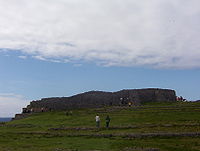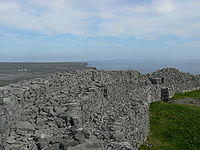
Dún Aengus
Encyclopedia


Aran Islands
The Aran Islands or The Arans are a group of three islands located at the mouth of Galway Bay, on the west coast of Ireland. They constitute the barony of Aran in County Galway, Ireland...
, of County Galway
County Galway
County Galway is a county in Ireland. It is located in the West Region and is also part of the province of Connacht. It is named after the city of Galway. Galway County Council is the local authority for the county. There are several strongly Irish-speaking areas in the west of the county...
, Ireland
Ireland
Ireland is an island to the northwest of continental Europe. It is the third-largest island in Europe and the twentieth-largest island on Earth...
. It is located on Inishmore at the edge of an approximately 100 metre high cliff.
A popular tourist attraction, Dún Aonghasa is an important archaeological site that also offers a spectacular view. It is not known when Dún Aonghasa was built, though it is now thought to date from the Iron Age
Iron Age
The Iron Age is the archaeological period generally occurring after the Bronze Age, marked by the prevalent use of iron. The early period of the age is characterized by the widespread use of iron or steel. The adoption of such material coincided with other changes in society, including differing...
. T. F. O'Rahilly
T. F. O'Rahilly
Thomas Francis O'Rahilly was an Irish scholar of the Celtic languages, particularly in the fields of Historical linguistics and Irish dialects. He was a member of the Royal Irish Academy.-Biography:He was born in Listowel, County Kerry, Ireland...
surmised that it was built in the 2nd century BC by the Builg
O'Rahilly's historical model
O'Rahilly's historical model is a theory of Irish prehistory put forward by Celtic scholar T. F. O'Rahilly in 1946. It was based on his study of the influences on the Irish language and a critical analysis of Irish mythology....
following the Laginian conquest of Connacht.

Aengus
In Irish mythology, Óengus , Áengus , or Aengus or Aonghus , is a member of the Tuatha Dé Danann and probably a god of love, youth and poetic inspiration...
", refers to the pre-Christian god of the same name described in Irish mythology
Irish mythology
The mythology of pre-Christian Ireland did not entirely survive the conversion to Christianity, but much of it was preserved, shorn of its religious meanings, in medieval Irish literature, which represents the most extensive and best preserved of all the branch and the Historical Cycle. There are...
, or the mythical king, Aonghus mac Úmhór
Aonghus mac Úmhór
Aengus mac Umor was a mythical Irish king.The Fir Bolg of Connacht were ruled by King Aonghus mac Úmhór. Dubhaltach Mac Fhirbhisigh states that Aonghus led his people, the Tuath mhac nUmhoir, to the coast of Galway Bay and the Aran Islands, after being driven out by warfare with "Clann Chuian and...
.
Form and function
The fort consists of a series of four concentric walls of dry stoneDry stone
Dry stone is a building method by which structures are constructed from stones without any mortar to bind them together. Dry stone structures are stable because of their unique construction method, which is characterized by the presence of a load-bearing facade of carefully selected interlocking...
construction, built on a high cliff some one hundred metres above the sea. Surviving stonework is four metres wide at some points. The original shape was presumably oval or D-shaped but parts of the cliff and fort have since collapsed into the sea. Outside the third ring of walls lies a defensive system of stone slabs, known as a cheval de frise
Cheval de frise
The cheval de frise was a Medieval defensive obstacle consisting of a portable frame covered with many long iron or wooden spikes or even actual spears. They were principally intended as an anti-cavalry obstacle but could also be moved quickly to help block a breach in another barrier...
, planted in an upright position in the ground and still largely well-preserved. These ruins also feature a huge rectangular stone slab, the function of which is unknown. Impressively large among prehistoric ruins, the outermost wall of Dún Aonghasa encloses an area of approximately 6 hectares (14 acres). Although clearly defensible, the particular location of Dún Aonghusa suggests that its primary purpose was religious and ceremonial rather than military. It may have been used for seasonal rites by the druid
Druid
A druid was a member of the priestly class in Britain, Ireland, and Gaul, and possibly other parts of Celtic western Europe, during the Iron Age....
s, perhaps involving the bonfire
Bonfire
A bonfire is a controlled outdoor fire used for informal disposal of burnable waste material or as part of a celebration. Celebratory bonfires are typically designed to burn quickly and may be very large...
s that could be seen from the mainland of Ireland
Ireland
Ireland is an island to the northwest of continental Europe. It is the third-largest island in Europe and the twentieth-largest island on Earth...
. The location also provides a view of as much as 120 km (75 mi) of coastline, which may have allowed for control over a coastal trading highway.
Visitor notes
The walls of Dún Aonghasa have been rebuilt to a height of 6m and have wall walks, chambers, and flights of stairs. The restoration is easily distinguished from the original construction by the use of mortar. Exploring Dún Aonghasa requires a bit of climbing, and there is no rail at the edge of the cliff, so it may not be a good place to visit with small children or people with mobility problems. There is a small museum illustrating the history of the fort and its possible functions. Also in the vicinity is a NeolithicNeolithic
The Neolithic Age, Era, or Period, or New Stone Age, was a period in the development of human technology, beginning about 9500 BC in some parts of the Middle East, and later in other parts of the world. It is traditionally considered as the last part of the Stone Age...
tomb and a small heritage park featuring examples of a traditional thatched cottage
Thatching
Thatching is the craft of building a roof with dry vegetation such as straw, water reed, sedge , rushes, or heather, layering the vegetation so as to shed water away from the inner roof. It is a very old roofing method and has been used in both tropical and temperate climates...
and an illegal poteen
Poitín
Poitín , anglicised as poteen, is a traditional Irish distilled, highly alcoholic beverage . Poitín was traditionally distilled in a small pot still and the term is a diminutive of the Irish word pota, meaning "pot"...
distillery.
Neighboring sites
Dún Dúchatair (Black Fort), Dún Eoghanachta (Fort of the EóganachtaEóganachta
The Eóganachta or Eoghanachta were an Irish dynasty centred around Cashel which dominated southern Ireland from the 6/7th to the 10th centuries, and following that, in a restricted form, the Kingdom of Desmond, and its offshoot Carbery, well into the 16th century...
), and Dún Eochla are similar prehistoric sites on Inishmore. Dún Chonchúir (Fort of Conchobar
Conchobar
is an Irish male name meaning "lover of hounds". It is the source of the Irish names Conor, Connor, Connors, Conner, O'Connor, etc. It is a name borne by several figures from Irish history and legend, including:* Conchobar mac Nessa, legendary king of Ulster...
) is located on nearby Inishmaan
Inishmaan
Inishmaan is the middle of the three main Aran Islands in Galway Bay on the west coast of Ireland. It is part of County Galway in the province of Connacht. Inishmaan has a population of about 160, making it the smallest of the Aran Islands in terms of population. It is also quieter and less...
.

